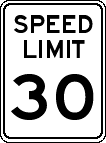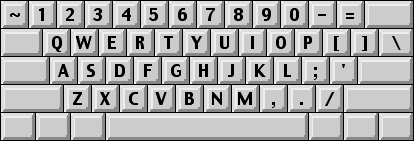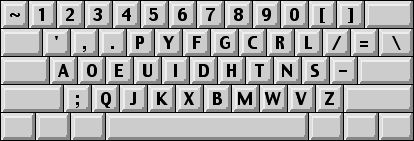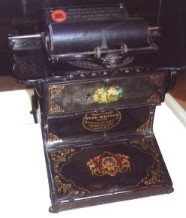
Keymileage calculates just how far your
fingers must travel to type something. Since the miles can really rack
up,
Keymileage allows you to measure very long files. Distance is tallied
for both the standard and the Dvorak keyboard layouts (see
below). Take a road trip with Keymileage today.
Note how the Dvorak home row actually contains comon letters!
Also, by placing the vowels only on the left hand and all the major
consonants on the right, Dvorak ensured that the typist develops a
steady hand-alternation motion. This can make typing faster. The real
reason people use Dvorak, however, is that they swear by its comfort.
Due to Dvorak's careful placement of letters, Dvorak typing is a very
fluid motion. It makes typing on Qwerty feel like drowning flailings. Also, because the most common letters in the language are
directly under one's fingers, one's hands simply don't move as much.
Dr. Dvorak reportedly claimed that a Qwerty-typing secretary would beat out between 12 and 20 miles of finger movement each day, while a Dvorak secretary would move only 1 mile. A later study calls that astronomical ratio into question.1 Keymileage lets you investigate the question yourself.
The Algorithm
Keymileage measures the number of inches between coordinates on the
keyboard as the
fingers are moving. At this time, the program makes no attempt to
estimate movement that occurs above the keys themselves; the simulated
typists are essentially sliding their fingers across the keys without
lifting them.
When a finger is moved to type a character, it is left on that key for the next three keystrokes, waiting for a new character to be typed with that same finger. If such a stroke does not arrive, the finger moves back to its default position on home row.
You don't have to keep forcing your fingers to do 60% more work than they need to. Just about any computer can be switched to Dvorak instantly, for free. Learning to type Dvorak (especially if you already know how to type) only takes a few weeks of total immersion. Unlike Qwerty, Dvorak actually makes sense, which dramatically facilitates the learning process. Dvorak converts often see a 10-20% speed increase2 as well. Most importantly, you will chop literally miles off your typing, which ought to work wonders for repetitive stress injury.
Switching to Dvorak does not mean forgetting Qwerty. I can still pound out Qwerty if I have to; now I simply loathe every second of it. Now accustomed to Dvorak, I cannot imagine wanting to switch back.
Further Information
Instructions for switching just about any
computer under the sun, as well as much more information can be found
at Marcus Brooks' "Introducing
the Dvorak Keyboard."
If you don't have a Mac (heaven forbid!), this Dvorak Java applet also calculates distances. Unfortunately, it cannot load in files, and computes in metric.
For the ultimate in keyboard nerdiness, read this positively fascinating study into creating a keyboard layout by evolutionary programming. The best evolved keyboard looks suspiciously familiar.
1 Ober, S. (1993). Relative efficiencies of the standard and
Dvorak Simplified keyboards. Delta
Pi
Epsilon Journal, 35, 1–13.
2 The fastest typist in the world, Barbara Blackburn, achieved 212 WPM with her Dvorak typewriter. It bears noting that she nearly flunked high-school typing.
|
|
Download KeymileageKeymileage 0.5.2 (248 K)Requires Mac OS X. You can find some very large text files at Project Gutenberg. Keymileage Source Code (180 KB) for XCode. |
|
History of the Typewriter KeyboardThe standard "QWERTY" keyboard was invented by Christopher Latham Sholes, to be used on the first commercially-produced typewriter in 1873. While designing the typewriter, Sholes found that his machine (pictured on the left) was subject to intolerably frequent jamming, especially when people typed nearby hammers too quickly. Armed
with a letter frequency chart, Sholes
scattered keys all over the keyboard to ensure that frequently-used
hammer combinations were never anywhere near each other. Now that
people had so much trouble finding the awkwardly-placed letters, they
couldn't type fast enough to jam the typewriter. The earliest
typewriters had little aspiration of exceeding the 30 words per minute
maximum of handwriting anyway. Armed
with a letter frequency chart, Sholes
scattered keys all over the keyboard to ensure that frequently-used
hammer combinations were never anywhere near each other. Now that
people had so much trouble finding the awkwardly-placed letters, they
couldn't type fast enough to jam the typewriter. The earliest
typewriters had little aspiration of exceeding the 30 words per minute
maximum of handwriting anyway.The jamming problem was solved by mechanical advances over a century ago. But you are still typing with a keyboard intentionally designed to make your life miserable. Thankfully, there is an alternative. |
 |
| Qwerty Keyboard |
The Dvorak Simplified Keyboard
In 1932, Dr. August Dvorak concluded years of research into letter frequency and typing motions by introducing a radically different keyboard layout. Dvorak's keyboard was painstakingly designed to be the best possible keyboard for the English language. |
| Dvorak Simplified Keyboard |
Dr. Dvorak reportedly claimed that a Qwerty-typing secretary would beat out between 12 and 20 miles of finger movement each day, while a Dvorak secretary would move only 1 mile. A later study calls that astronomical ratio into question.1 Keymileage lets you investigate the question yourself.
The Algorithm
Keymileage measures the number of inches between coordinates on the
keyboard as the
fingers are moving. At this time, the program makes no attempt to
estimate movement that occurs above the keys themselves; the simulated
typists are essentially sliding their fingers across the keys without
lifting them.When a finger is moved to type a character, it is left on that key for the next three keystrokes, waiting for a new character to be typed with that same finger. If such a stroke does not arrive, the finger moves back to its default position on home row.
My Conclusions
After analyzing over 50 MB of English, a trend had clearly emerged. Using the Dvorak keyboard results in at least a 38% reduction of finger travel over Qwerty. The figure is fairly consistent, from Elizabethan English to all the e-mail I've ever typed. The Decline and Fall of the Roman Empire, weighing in at 9.1 MB, exhibits the ratio almost perfectly; the 88 miles it requires under Dvorak is only 62% of the Qwerty distance.The Altar Call
(cue the revival music if you need it)You don't have to keep forcing your fingers to do 60% more work than they need to. Just about any computer can be switched to Dvorak instantly, for free. Learning to type Dvorak (especially if you already know how to type) only takes a few weeks of total immersion. Unlike Qwerty, Dvorak actually makes sense, which dramatically facilitates the learning process. Dvorak converts often see a 10-20% speed increase2 as well. Most importantly, you will chop literally miles off your typing, which ought to work wonders for repetitive stress injury.
Switching to Dvorak does not mean forgetting Qwerty. I can still pound out Qwerty if I have to; now I simply loathe every second of it. Now accustomed to Dvorak, I cannot imagine wanting to switch back.
Further Information
Instructions for switching just about any
computer under the sun, as well as much more information can be found
at Marcus Brooks' "Introducing
the Dvorak Keyboard."If you don't have a Mac (heaven forbid!), this Dvorak Java applet also calculates distances. Unfortunately, it cannot load in files, and computes in metric.
For the ultimate in keyboard nerdiness, read this positively fascinating study into creating a keyboard layout by evolutionary programming. The best evolved keyboard looks suspiciously familiar.
This webpage took 297 feet 5
inches to type.
2 The fastest typist in the world, Barbara Blackburn, achieved 212 WPM with her Dvorak typewriter. It bears noting that she nearly flunked high-school typing.

